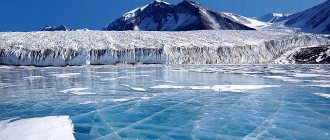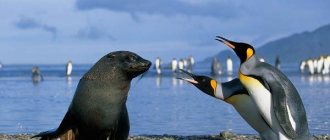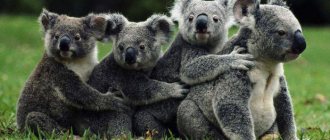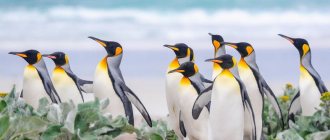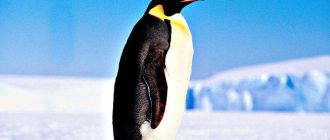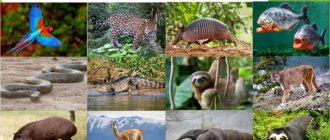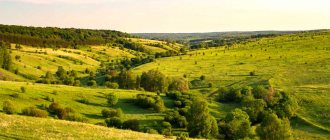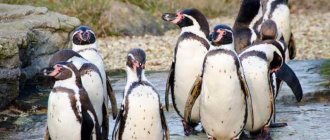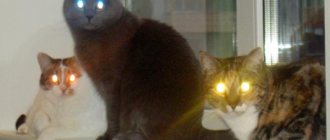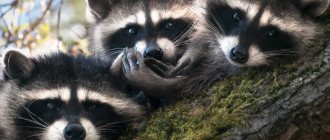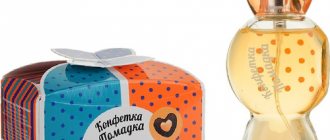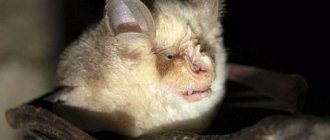- Wild animals
- >>
- Birds
The Adelie penguin is a unique creature. Everyone is touched by their funny way of waddling from paw to paw and flapping their wings on their sides. And the fluffy little balls of chicks and their parents, gliding across the ice as if on a sleigh, look especially cute. It was the life of Adelie penguins in Antarctica that prompted Japanese and Soviet animators to create the cartoons “The Adventures of Lolo the Penguin” and “Happy Feet.”
Origin of the species and description
Photo: Adelie Penguin
The Adelie penguin (in Latin Pygoscelis adeliae) is a non-flying bird belonging to the order Penguinidae. These birds are one of three species of the genus Pygoscelis. Mitochondrial and nuclear DNA indicate that the genus split from other penguin species about 38 million years ago, about 2 million years after the ancestors of the genus Aptenodytes. In turn, Adelie penguins split off from other members of the genus approximately 19 million years ago.
Video: Adelie Penguin
The first penguins began to waddle about 70 million years ago. Their ancestors lost the ability to soar in the sky and turned into universal swimmers. The birds' bones have become heavy, which helps them dive better. Now these funny birds “fly” underwater.
Penguin fossils were first discovered in 1892. Previously, scientists had assumed that these awkward creatures with miniature wings were primitive birds that had failed to master flight. Then the origin was clarified: the ancestors of penguins were keeled tube-nosed birds - a fairly highly developed group of petrels.
The first penguins appeared in Antarctica about 40 million years ago. At the same time, several species lived on the ocean shore and led an exclusively land-based lifestyle. Among them were real giants, for example, Anthropornis, whose height reached 180 cm. Their ancestors did not have dangerous enemies in the freezing Antarctica, so penguins lost the ability to fly, adapted to low temperatures and became universal swimmers.
INTERESTING FACTS, INFORMATION…
- A population of approximately 5 million Adélie penguins consumes 9,000 tonnes of food daily during their peak breeding season. This quantity corresponds to 70 fully loaded fishing boats.
- The insulating subcutaneous fat layer and waterproof plumage protect penguins from the cold so well that they can even be at risk of overheating. In this case, the penguin spreads its wings horizontally to get rid of excess heat.
- During the long transition to the nesting sites, nest construction and the initial nesting phase, penguins go hungry. This fast lasts about 6 weeks. During this time, birds lose up to 40% of their weight.
Appearance and features
Photo: Adelie penguins in Antarctica
Adelie penguins (P. adeliae) are the most studied of all 17 species. They were named after Adélie Land, where they were first described in 1840 by French ornithologist Jules Dumont d'Urville, who named this part of the Antarctic continent after his wife Adéle.
Compared to other penguins, they have a common black and white plumage. However, this simplicity provides good camouflage against predators and when hunting prey - a black back in the dark sea depths and a white belly on the bright sea surface above. Males are only slightly larger than females, especially their bills. Bill length is often used to determine sex.
Adelie penguins weigh between 3.8 kg and 5.8 kg depending on their breeding stage. They are medium in size with a height of 46 to 71 cm. Distinctive features are a white ring surrounding the eyes and feathers hanging over the beak. The beak is red in color. The tail is slightly longer than that of other birds. Externally, the entire outfit looks like a tuxedo of a representative person. Adélie is slightly smaller than most known species.
These penguins usually swim at a speed of about 8.0 km/h. They can jump about 3 meters out of the water to land on rocks or ice. This is the most common type of penguin.
FOOD
Allely the penguin searches for food in sea water. The main part of its diet is krill. In addition, the bird consumes cephalopods, some other mollusks and small fish.
Thanks to its characteristics, the penguin Allely can make the best use of the energy obtained from food. During the day, Allely the penguin consumes only about two kilograms of food.
While swimming, the bird uses its wings to reach speeds of more than 20 km/h. The large legs of this bird have swimming membranes that act as a rudder and help the Allely penguin stay in a certain direction.
Where does the Adelie penguin live?
Photo: Adelie penguin bird
They live only in the Antarctic region. They nest on the coasts of Antarctica and neighboring islands. The area with the largest Adélie penguin population is in the Ross Sea. Living in the Antarctic region, these penguins must withstand very cold temperatures. During the winter months, Adélie inhabit large coastal ice platforms to gain better access to food.
Krill, the main product in the diet. They feed on plankton living under the sea ice, so they choose areas with an abundance of krill. During the breeding season, usually in early spring and summer months, they travel to coastal beaches to build their nests in ice-free areas. With access to open water in this region, adults and their young are given almost immediate access to food.
Adélie penguins, native to the Ross Sea region of Antarctica, migrate an average of about 13,000 km each year, following the sun from their breeding colonies to their winter feeding grounds and back.
During winter, the sun does not rise south of the Arctic Circle, but sea ice grows during the winter months and expands hundreds of miles off the coastline and moves to more northern latitudes throughout Antarctica. As long as penguins live on the edge of fast ice, they will see sunlight.
When the ice recedes in the spring, the penguins remain on the edge until they are back on the shoreline during the sunnier season. The longest treks were recorded at 17,600 km.
Habitats, lifestyle
Between April and October, life in the polar latitudes of the southern hemisphere is very bleak. During this period, representatives of the species live in the sea. They go far from their nesting sites - 700 km. Here they rest, eat food to gain strength, since after this they will have to starve for quite a long time.
In October, the birds return to their nesting site. The weather at that time was very harsh.
The rest of the time the birds are in the ocean near the pack ice. You can meet representatives of this penguin-like species on the rocky coasts of Antarctica, as well as on the islands located nearby - South Sandwich, South Scotland.
What does an Adelie penguin eat?
Photo: Adelie Penguin
They feed mainly on a mixed diet of Antarctic krill Euphausia superba and ice krill E. crystalorophias, although the diet shifts throughout the year towards fish (mainly Pleuragramma antarcticum) in the breeding season and squid in the winter. The menu varies depending on geographical location.
The diet of Adelie penguins boils down to the following foods:
- ice fish;
- sea krill;
- ice squids and other cephalopods;
- fish lantern;
- glowing anchovies;
- amphipods are also part of their regular diet.
Jellyfish, including species of the genera Chrysaora and Cyanea, have been found to be extensively consumed by Adelie penguins as food, although it was previously thought that they were only ingested accidentally. Similar preferences have been found in several other species: the yellow-eyed penguin and the Magellanic penguin. Adelie penguins store food and then regurgitate it to feed their young.
When diving from the surface of the water to the depth at which they find their prey, Adelie penguins use a cruising speed of 2 m/s, which is considered to be the speed that provides minimum energy expenditure. However, once they reach the dense schools of krill at the base of their dives, they slow down to catch their prey. Generally, Adelie penguins prefer heavy female krill with eggs, which has a higher energy content.
By studying the remains accumulated in the colonies over the past 38,000 years, scientists concluded that there was a sudden change in the diet of Adelie penguins. They switched from fish as their main food source to krill. It all started about 200 years ago. This is most likely due to the decline in the number of fur seals since the end of the 18th century and of baleen whales at the beginning of the 20th century. Reduced competition from these predators has resulted in a surplus of krill. It is now used by penguins as an easier food source.
Osmoregulation
Adélie penguins face extreme osmotic conditions because their frozen habitats offer little fresh water. These desert conditions mean that the vast majority of available water is highly saline, resulting in a high salt diet for Adélie penguins.[33] They manage to get around this problem by eating krill with internal salt concentrations at the lower end of their possible concentrations, which helps reduce the amount of salts they absorb.[33] The amount of sodium associated with such a diet is still relatively high and can be problematic when considering less tolerant chickens. Adult Adelie penguins feed their chicks by regurgitating pre-digested krill, which can cause the chicks to consume too much salt. Adult birds solve this problem by changing the ion concentration while the food is still in their stomachs. By removing some of the sodium and potassium ions, adult Adelie penguins protect their chicks from excessive sodium consumption.[33] Adélie penguins also regulate their salt intake by concentrating cloacal fluid to a much greater extent than most other birds are capable of. This ability is present regardless of ontogeny in Adélie penguins, meaning that both adults and juveniles are capable of extreme levels of salt ion concentrations.[33] However, chickens have a greater ability to concentrate chloride ions in the cloacal fluids.[33]Salt glands also play an important role in excreting excess salts. In aquatic birds such as the Adélie penguin, nasal salt glands secrete an extremely concentrated solution of sodium chloride, reducing the burden on their kidneys.[34]
These secretions are critical to maintaining Antarctic ecosystems. Penguin rookeries can be home to thousands of penguins, all of which concentrate waste products in the digestive tract and nasal glands.[35] These secretions inevitably fall to the ground. The concentration of salts and nitrogenous waste helps facilitate the flow of material from the sea to land, making it suitable for bacteria living in the soil.[35]
Features of character and lifestyle
Photo: Adelie penguins in Antarctica
Pygoscelis adeliae is a highly social species of penguin. They constantly interact with other individuals in their group or colony. Adeles travel together from the pack ice to their nesting grounds when the breeding season begins. Mated pairs defend the nest. Adelie penguins also hunt in groups, as this reduces the risk of predation and increases the efficiency of searching for food.
Adelie penguins can fly out of the water to skim above the surface for several meters before plunging back into the water. When leaving the water, penguins breathe air quickly. On land they can travel in different ways. Adelie penguins walk in an upright position, propelling themselves using a double jump, or can slide on their bellies on ice and snow.
Their annual cycle can be summarized by the following milestones:
- preliminary fattening period at sea;
- migration to the colony around October;
- nesting and raising young (about 3 months);
- migration in February with constant feeding;
- molting on ice in February-March.
On land, Adelie penguins have a visually sluggish appearance, but when at sea, they become like a torpedo swimmer, hunting prey at depths of up to 170 m and staying in the water for more than 5 minutes. However, most of their diving activity is concentrated in the 50 m water layer because, as visual predators, their maximum diving depth is determined by the penetration of light into the deep ocean.
These penguins have a series of physiological and biochemical adaptations that allow them to extend their time underwater, something that other penguins of similar size cannot endure.
Notes and links
Notes
- About 100 booklets of the notes he took were sent out to a select few with bold headings Not for publication
. Levik himself was equally cautious. References to these observations in the notebooks were often encoded by his transcribing certain entries about this behavior using the Greek alphabet and then inserting this new text over the original entry (Figure 1), while some entries were written directly in the Greek alphabet."[27 ] Below is an example of such a note; transcription into the English alphabet is given on the right:Ις ἀφτερνooν ἰ σαυ ἀ μoστ εχτραoρδιναρι σιtε. ἀ πενγυιν ὐας ἀκτυαλλι ενyαyεδ ἰν σoδoμι ᾿uπoν θε βoδι ὀφ ἀ δεαδ ὑιτε θ ρoατεδ βιρδ ὀφ ἰτς ὀνε σπεσιες. Θε ἀκτ ὀccυπιεδ ἀ φυλλ μινυτε, θε πoσιτιoν τακεν ὐπ βι θε κoχ διφφερινy ἰν νo ρεσπεκτ φρoμ θατ ὀφ ὀρδιναρι κoπυλατιoν, ἀνδ θε ὑoλε ακτ ὐας yoνε θρ oυ, δoυν τo θε φιναλ δεπρεςςιoν ὀφ θε χλoακα.[27]
This afternoon I saw a very unusual site [sic]. The penguin actually raped the body of a dead white-throated bird of his species. The action took place for a whole minute, the position of the penis was no different from the position of ordinary copulation, and the entire act lasted until the last pressure on the penis. cloaca.[27]
References
- BirdLife International (2012). " Pygoscelis adeliae
".
IUCN Red List of Threatened Species
.
2012
. Retrieved November 26, 2013.CS1 maint: ref=harv (website link)Old form URL - ^ a b
"Adélie Penguin".
World Wildlife Fund
. Retrieved October 19, 2022. - Adele, adj.
and n. OED Online. Oxford University Press, March 2014. Accessed April 11, 2014. - Baker A.J., Pereira S.L., Haddrath O.P., Edge K.A. (2006). "Multiple genetic evidence for expansion of modern penguins beyond Antarctica due to global cooling." Proc Biol Sci
.
273
(1582): 11–17. Doi:10.1098/rspb.2005.3260. PMC 1560011. PMID 16519228. - "Adelie Penguin (Pygoscelis adeliae)." ARKive. Archived from the original on November 5, 2011. Retrieved November 6, 2011.
- "Adélie Penguin" Sea World
. Archived from the original on November 21, 2011. Retrieved December 1, 2011. - "Swimming Answers." Penguin Science
. National Science Foundation. Retrieved November 6, 2015. - "Adélie Penguin" Global educational project
. Retrieved November 4, 2022. - SD Emsley; W. P. Patterson (July 2007). "A dramatic recent shift in δ13C and δ15N values in Adélie penguin eggshells in Antarctica." Proceedings of the National Academy of Sciences
.
104
(28):11666–11669. doi:10.1073/pnas.0608477104. PMC 1913849. PMID 17620620. - Christy Wilcox (September 15, 2022). "Penguins Caught in Unexpected Prey." National Geography
. - “Adelie Penguin | bird". Encyclopedia Britannica
. Retrieved February 25, 2022. - Graham, Rex (15 July 2014). "Adélie Penguins Thrive in Antarctica's Melting Ice." Bird News
. Archived from the original on June 5, 2016. Retrieved July 16, 2014. - ^ a b
Eccleston, Paul (11 December 2007).
"Penguins are threatened by global warming." Telegraph
. - Schwaller, M. R.; Southwell, S. J.; Emmerson, L. M. (2013). "Mapping Adélie penguin colonies at a continental scale from Landsat imagery." Remote Sensing of the Environment
.
139
: 353–364. doi:10.1016/j.rse.2013.08.009. - "Winners and Losers of Climate Change." 3 News NZ
. April 4, 2013. Archived from the original on November 2, 2013. Retrieved May 27, 2013. - "BirdLife Data Zone". BirdLife International
. Retrieved March 4, 2022. - Borowicz, Alex; McDowall, Philip; Youngflash, Casey; Sayre-McCord, Thomas; Clucas, Gemma; Herman, Rachel; Forrest, Stephen; Ryder, Melissa; Schwaller, Matthew (2 March 2022). "Multi-modal survey of Adélie penguin megacolonies reveals Danger Islands are a hotspot for seabirds." Scientific reports
.
8
(1):3926. doi:10.1038/s41598-018-22313-w. ISSN 2045-2322. PMC 5834637. PMID 29500389. - May, Ashley (2 March 2022). "NASA Satellite Images of Poop Lead Researchers to Penguin SuperColony." USA Today
. Retrieved March 4, 2022. - Cherry-Garrard, Apsley (2000). The Worst Trip in the World
. Picador. paragraph 64. ISBN 978-0-330-48135-9. - Levick, Chinstrap Penguins, p. 83
- Scott's Last Expedition
vol. I pp. 92–3 - Cherry-Garrard, Apsley (2000). The Worst Trip in the World
. Picador. paragraph 65. ISBN 978-0-330-48135-9. - Cherry-Garrard, Apsley (2000). The Worst Trip in the World
. Picador. paragraph 85. ISBN 978-0-330-48135-9. - Aglietti, Tom. "Penguin chicks saved by an unlikely hero." BBC Earth
. Retrieved December 13, 2022. - Ouellette, Jennifer (July 4, 2022). "The Explosive Physics of Pooping Penguins: They Can Shoot Poop from Over Four Feet." Ars Technica
. Retrieved July 8, 2022. - McKie, Robin (9 June 2012). "'The Sexual Depravity of Penguins That Antarctic Scientist Didn't Dare to Reveal.' The keeper
. - ^ a b c d
Russell, D. G. D.;
Sladen, W. J. L.; Ainley, D. G. (2012). "Dr. George Murray Levick (1876–1956): unpublished notes on the sexual habits of an Adelie penguin." Polar record
.
48
(4): 1. Doi:10.1017/S0032247412000216. S2CID 146584734. - ^ a b c
McKie, Robin (9 June 2012).
"'The Sexual Depravity of Penguins That Antarctic Scientist Didn't Dare to Reveal.' The keeper
. Retrieved June 9, 2012. - "Shock over sexually 'depraved' penguins led to 100 years of censorship." A week
. June 10, 2012 - Ainley, David G. (2002). The Adelie Penguin: A Harbinger of Climate Change
. Columbia University Press. p.310 pp. with 23 illustrations, 51 figures, 48 tables, 16 tables. ISBN 978-0-231-12306-8. - Lescroël, A. L.; Ballard, G.; Grémillet, D.; Authier, M.; Ainley, D. G. (2014). Descamps, Sebastian (ed.). "Antarctic climate change: extreme events disrupt plastic phenotype responses in Adelie penguins." PLOS One
.
9
(1):e85291. Doi:10.1371/journal.pone.0085291. PMC 3906005. PMID 24489657. - Reichek, Peter (13 August 2010). "Researchers observe winter migration of Adélie penguins for the first time." Antarctic sun
. - ^ a b c d e
Jaynes, Donald (1997).
"Osmoregulation of Adélie penguin chicks on the Antarctic Peninsula". Auk
.
114
(3):488–495. Doi:10.2307/4089249. JSTOR 4089249. - Schmidt-Nielsen, Knut (1980). "The salt gland of seabirds." Circulation
.
21
(5):955–967. Doi:10.1161 / 01.cir.21.5.955. PMID 14443123. - ^ a b
Andrzej, Mircea;
Anderzey, Tatur (1991). "The ecological role of modern and abandoned penguin breeding grounds in the terrestrial environment of marine Antarctica." Polish Polar Research
.
12
(1): 3–24.
Social structure and reproduction
Photo: Female Adelie penguin
Male Adelie penguins, attracting the attention of females, demonstrate an upturned beak, a curved neck and an elongated body. These movements also serve to claim territory in the colony as their own. In early spring, Adelie penguins return to their breeding grounds. The males arrive first. Each pair responds to each other's mating call and heads to the site where they nested the previous year. Couples may reunite for several years in a row.
The increase in spring days encourages penguins to begin a period of constant feeding to store the fat they need during the breeding and incubation periods. Birds build stone nests in preparation for two eggs. Adelie penguins most often have two young per season, with one egg laid shortly after the first. The eggs are incubated for about 36 days. The parents take turns caring for the young penguins for about 4 weeks after hatching.
Both parents do a lot for their children. During incubation, males and females take turns holding the egg while the other spouse “feeds.” Once the chick has hatched, both adults take turns searching for food. Newborn chicks are born with downy feathers and are unable to feed themselves. Four weeks after the chick hatches, it will join other juvenile Adélie penguins for better protection. In the crèche, the parents still feed their young and it is only after 56 days in the crèche that most Adélie penguins become independent.
GENERAL PROVISIONS
In pursuit of prey, the basis of which is krill, they often make dolphin-like jumps, so a flock of Adélie penguins are often mistaken from afar for small dolphins.
This penguin, like the emperor, is a resident of Antarctica. These are cheerful and sociable birds up to 75 cm high, weighing 5-6 kg. In winter they travel in the ocean, swimming thousands of kilometers from their nesting sites. The streamlined body shape and short neck facilitate their movement in the water. Small feathers adhere to each other, like tiles, and form a waterproof plumage. And thanks to the fluff and the layer of fat underneath, the penguin’s body does not become overcooled. In October (late spring in Antarctica) they prepare to build nests. They are laid out inside with pebbles and 2 eggs are laid in November-December. The first weeks they are incubated by the father, then the parents alternate. Chicks that have grown up are sent to a “nursery”. Returning from hunting, parents find and feed their children.
Natural enemies of the Adelie penguin
Photo: Adelie penguins
Leopard seals are the most common predator of Adelie penguins, attacking near the edge of the ice crust. Leopard seals are not a problem for penguins on shore because leopard seals only come ashore to sleep or rest. Adélie penguins have learned to avoid these predators by swimming in groups, avoiding thin ice and spending little time in the water within 200m of their beach. Killer whales typically prey on larger penguin species, but may occasionally feast on adeles.
The South Pole Skua preys on eggs and chicks that are left unattended by adults or that are located at the edges of cells. The snowy plover (Chionis albus) will also sometimes attack unguarded eggs. Adelie penguins face predation by leopard seals and killer whales at sea, and giant petrels and skuas on land.
The main natural enemies of Adelie penguins are:
- killer whales (Orcinus orca);
- leopard seals (H. leptonyx);
- south polar skuas (Stercorarius maccormicki);
- white plover (Chionis albus);
- giant petrel (Macronectes).
Adelie penguins are often good indicators of climate change. They are beginning to colonize beaches that were previously permanently covered in ice, signaling a warming Antarctic environment. Adelie penguin colonies are the best for ecotourism in Antarctica. From the eighteenth to the early twentieth century, these penguins were used for food, oil, and bait. Their guano was mined and used as fertilizer.
Distribution and habitat[edit]
Adelie penguins on an iceberg in Antarctica
Based on satellite analysis of fresh red-brown coastal areas stained with guano in 2014, there are 3.79 million breeding pairs of Adélie penguins in 251 breeding colonies [12], a 53% increase from the census reported 20 years earlier. Colonies are distributed along the coastlines of Antarctic land and ocean. Colonies on the Antarctic Peninsula have declined since the early 1980s [13], but this decline has been more than offset by an increase in East Antarctica [ citation needed
] . During the breeding season, they gather in large breeding colonies, some of which number more than a quarter of a million pairs. [14]The size of individual colonies can vary greatly, and some may be particularly vulnerable to climate fluctuations. [15] The At Risk Islands have been identified as an "important bird area" by BirdLife International in large part because it supports Adelie penguin colonies, [16] with 751,527 pairs recorded from at least five different colonies. In March 2022, a colony with a population of 1.5 million was discovered. [17] [18]
Adélie penguins breed from October to February on the shores of the Antarctic continent. Adeles build crude nests out of stones. Two eggs are laid; they are incubated by their parents in turns for 32 to 34 days (usually a shift lasts 12 days). The chicks remain in the nest for 22 days before joining the crèche. The chicks molt into young plumage and go to sea after 50–60 days.
